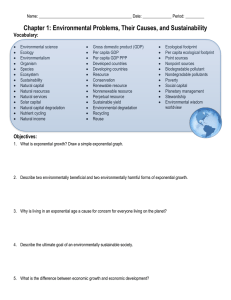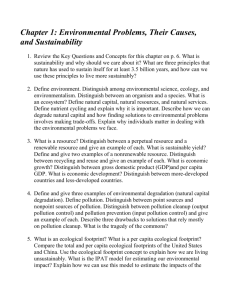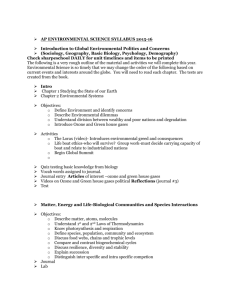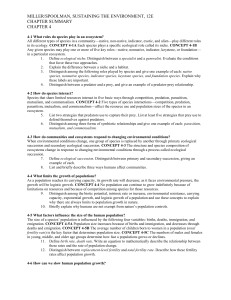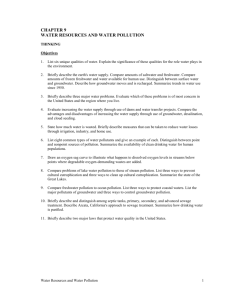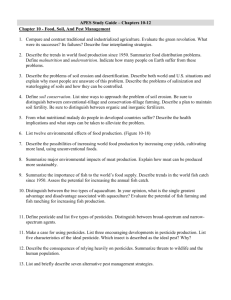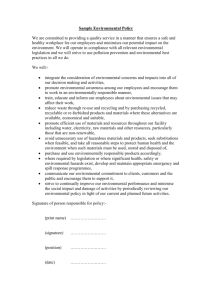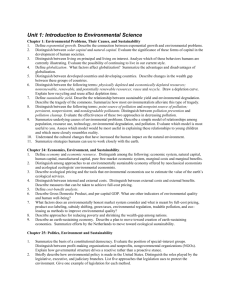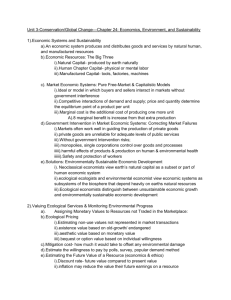reuse environmentally
advertisement
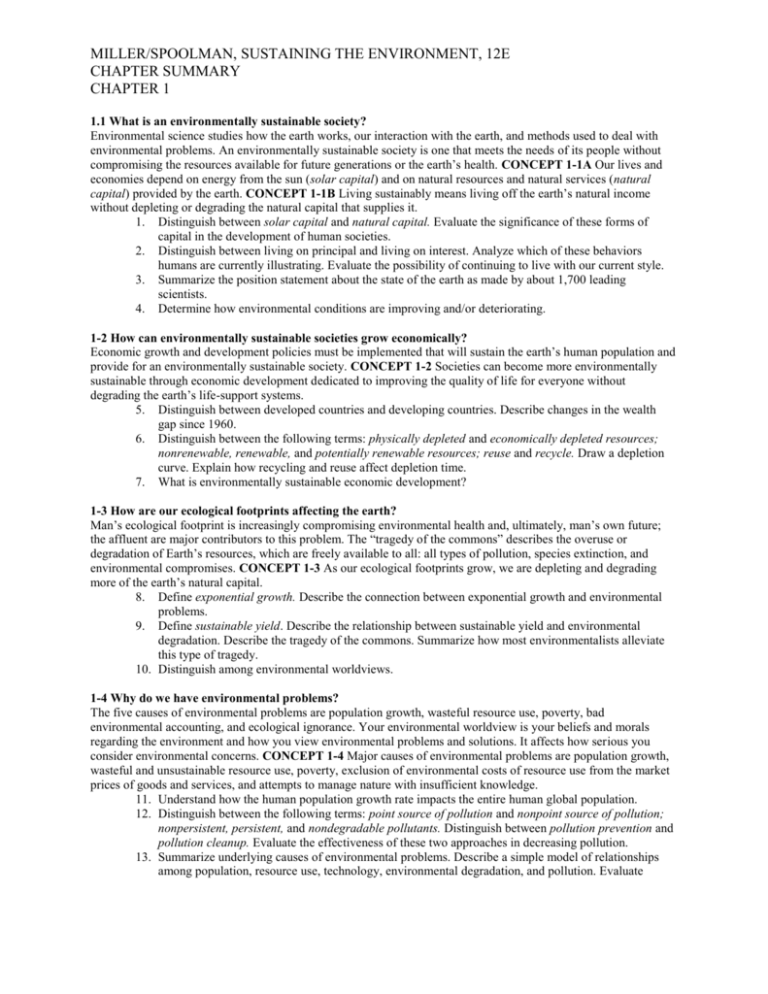
MILLER/SPOOLMAN, SUSTAINING THE ENVIRONMENT, 12E CHAPTER SUMMARY CHAPTER 1 1.1 What is an environmentally sustainable society? Environmental science studies how the earth works, our interaction with the earth, and methods used to deal with environmental problems. An environmentally sustainable society is one that meets the needs of its people without compromising the resources available for future generations or the earth’s health. CONCEPT 1-1A Our lives and economies depend on energy from the sun (solar capital) and on natural resources and natural services (natural capital) provided by the earth. CONCEPT 1-1B Living sustainably means living off the earth’s natural income without depleting or degrading the natural capital that supplies it. 1. Distinguish between solar capital and natural capital. Evaluate the significance of these forms of capital in the development of human societies. 2. Distinguish between living on principal and living on interest. Analyze which of these behaviors humans are currently illustrating. Evaluate the possibility of continuing to live with our current style. 3. Summarize the position statement about the state of the earth as made by about 1,700 leading scientists. 4. Determine how environmental conditions are improving and/or deteriorating. 1-2 How can environmentally sustainable societies grow economically? Economic growth and development policies must be implemented that will sustain the earth’s human population and provide for an environmentally sustainable society. CONCEPT 1-2 Societies can become more environmentally sustainable through economic development dedicated to improving the quality of life for everyone without degrading the earth’s life-support systems. 5. Distinguish between developed countries and developing countries. Describe changes in the wealth gap since 1960. 6. Distinguish between the following terms: physically depleted and economically depleted resources; nonrenewable, renewable, and potentially renewable resources; reuse and recycle. Draw a depletion curve. Explain how recycling and reuse affect depletion time. 7. What is environmentally sustainable economic development? 1-3 How are our ecological footprints affecting the earth? Man’s ecological footprint is increasingly compromising environmental health and, ultimately, man’s own future; the affluent are major contributors to this problem. The “tragedy of the commons” describes the overuse or degradation of Earth’s resources, which are freely available to all: all types of pollution, species extinction, and environmental compromises. CONCEPT 1-3 As our ecological footprints grow, we are depleting and degrading more of the earth’s natural capital. 8. Define exponential growth. Describe the connection between exponential growth and environmental problems. 9. Define sustainable yield. Describe the relationship between sustainable yield and environmental degradation. Describe the tragedy of the commons. Summarize how most environmentalists alleviate this type of tragedy. 10. Distinguish among environmental worldviews. 1-4 Why do we have environmental problems? The five causes of environmental problems are population growth, wasteful resource use, poverty, bad environmental accounting, and ecological ignorance. Your environmental worldview is your beliefs and morals regarding the environment and how you view environmental problems and solutions. It affects how serious you consider environmental concerns. CONCEPT 1-4 Major causes of environmental problems are population growth, wasteful and unsustainable resource use, poverty, exclusion of environmental costs of resource use from the market prices of goods and services, and attempts to manage nature with insufficient knowledge. 11. Understand how the human population growth rate impacts the entire human global population. 12. Distinguish between the following terms: point source of pollution and nonpoint source of pollution; nonpersistent, persistent, and nondegradable pollutants. Distinguish between pollution prevention and pollution cleanup. Evaluate the effectiveness of these two approaches in decreasing pollution. 13. Summarize underlying causes of environmental problems. Describe a simple model of relationships among population, resource use, technology, environmental degradation, and pollution. Evaluate MILLER/SPOOLMAN, SUSTAINING THE ENVIRONMENT, 12E CHAPTER SUMMARY CHAPTER 1 which model is most useful to you. Assess which model would be most useful in explaining these relationships to young children and which more closely resembles reality. 14. Distinguish how cultural developments have impacted the natural environment. 1-5 What are four scientific principles of sustainability? The four principles of sustainability include reliance on solar energy, nutrient recycling, biodiversity, and population control in order to minimize environmental damage by humans. CONCEPT 1-5 Nature has sustained itself for billions of years by using solar energy, biodiversity, population control, and nutrient cycling—lessons from nature that we can apply to our lifestyles and economies. 15. Summarize strategies humans can use to work closely with the earth. 16. Understand how principles of sustainability can be formulated into guidelines for developing sustainable societies and lifestyles. 17. List three ways you could apply the four principles of sustainability to making your life more environmentally sustainable.
